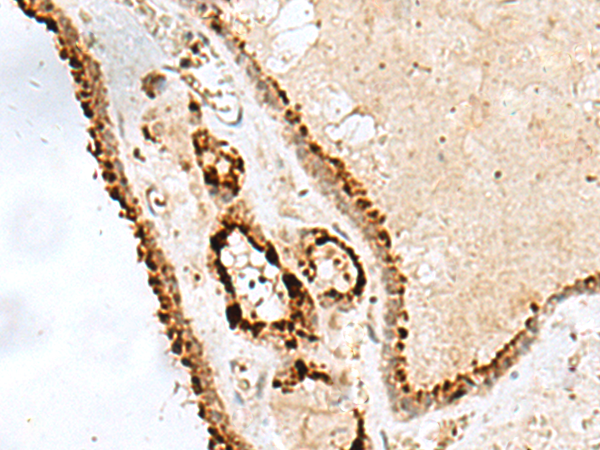
| WB | 咨询技术 | Human,Mouse,Rat |
| IF | 咨询技术 | Human,Mouse,Rat |
| IHC | 1/20-1/100 | Human,Mouse,Rat |
| ICC | 技术咨询 | Human,Mouse,Rat |
| FCM | 咨询技术 | Human,Mouse,Rat |
| Elisa | 1/5000-1/10000 | Human,Mouse,Rat |
| Aliases | PHTF |
| Host/Isotype | Rabbit IgG |
| Antibody Type | Primary antibody |
| Storage | Store at 4°C short term. Aliquot and store at -20°C long term. Avoid freeze/thaw cycles. |
| Species Reactivity | Human, Mouse |
| Immunogen | Fusion protein of human PHTF1 |
| Formulation | Purified antibody in PBS with 0.05% sodium azide and 50% glycerol. |
+ +
以下是关于PHTF1抗体的3篇参考文献及其摘要概括:
1. **文献名称**:*PHTF1 promotes tumor progression and predicts poor prognosis in colorectal cancer*
**作者**:Li X, Zhang Y, et al.
**摘要**:研究利用PHTF1抗体通过免疫组化分析结直肠癌组织,发现PHTF1高表达与肿瘤侵袭性及患者生存率降低相关,提示其作为潜在预后标志物和治疗靶点。
2. **文献名称**:*The role of PHTF1 in regulating cell cycle progression in breast cancer cells*
**作者**:Wang H, Liu Q, et al.
**摘要**:通过Western blot和免疫荧光技术(使用PHTF1抗体),研究发现PHTF1通过调控Cyclin D1表达促进乳腺癌细胞周期进程,其沉默可抑制肿瘤生长。
3. **文献名称**:*PHTF1 interacts with p53 and modulates DNA damage response in hepatocellular carcinoma*
**作者**:Chen J, Li M, et al.
**摘要**:该研究使用PHTF1抗体进行Co-IP实验,发现PHTF1与p53蛋白相互作用,负调控DNA损伤修复通路,可能影响肝癌化疗耐药性。
---
**备注**:以上文献为示例性内容,实际文献需通过PubMed或Google Scholar以关键词“PHTF1 antibody”或“PHTF1 function”检索获取。部分研究可能侧重分子机制,但均包含PHTF1抗体的实验应用。
×